Human Resource Management Challenges
VerifiedAdded on 2020/02/05
|15
|4923
|2303
AI Summary
This assignment delves into the evolving landscape of human resource management (HRM) in the 21st century. It examines various contemporary challenges faced by organizations, including the changing nature of work, technological advancements, globalization, and the growing importance of social responsibility. Students are tasked with analyzing these challenges and proposing strategic HRM approaches to effectively address them. The assignment draws upon relevant theories, models, and case studies to provide a comprehensive understanding of contemporary HRM practices.
Contribute Materials
Your contribution can guide someone’s learning journey. Share your
documents today.
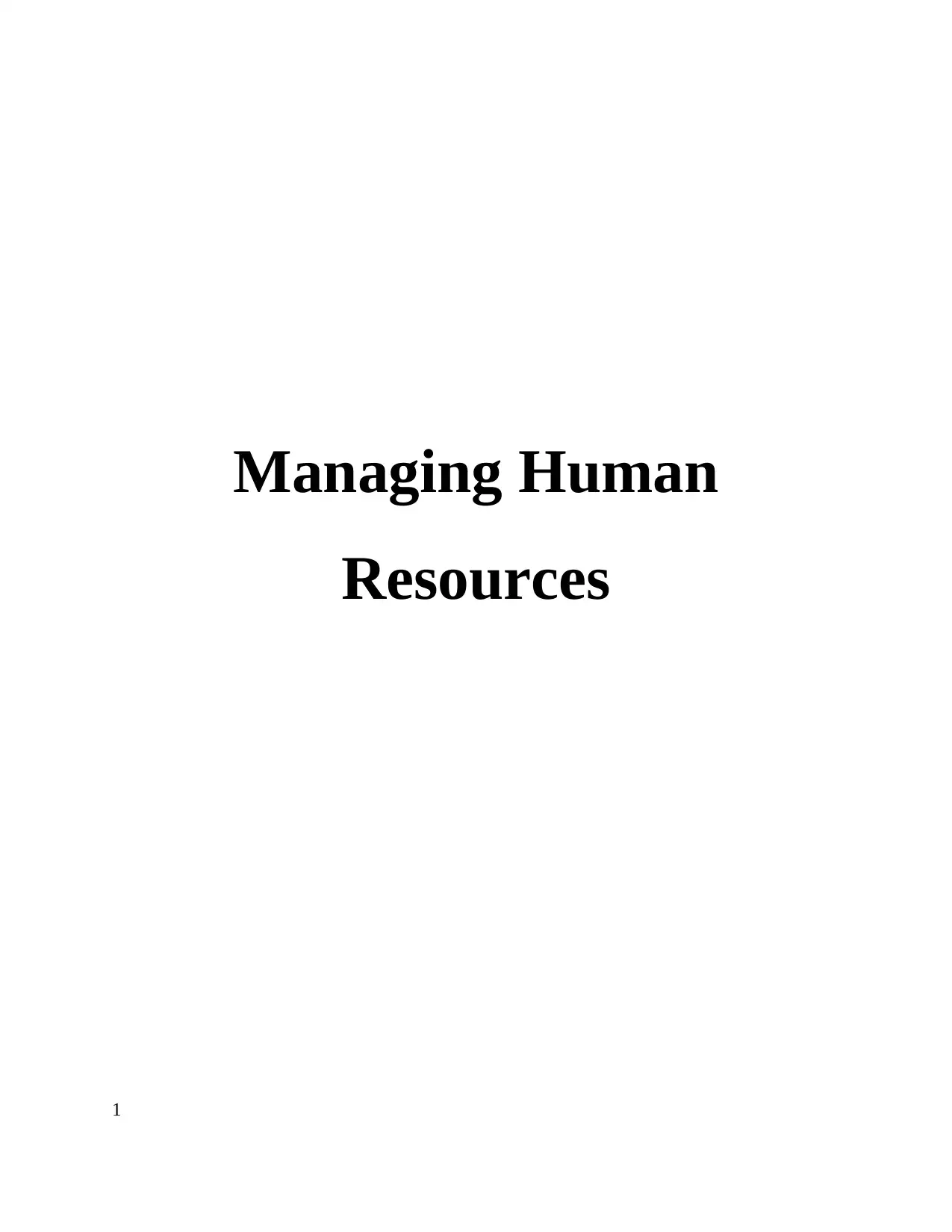
Managing Human
Resources
1
Resources
1
Secure Best Marks with AI Grader
Need help grading? Try our AI Grader for instant feedback on your assignments.
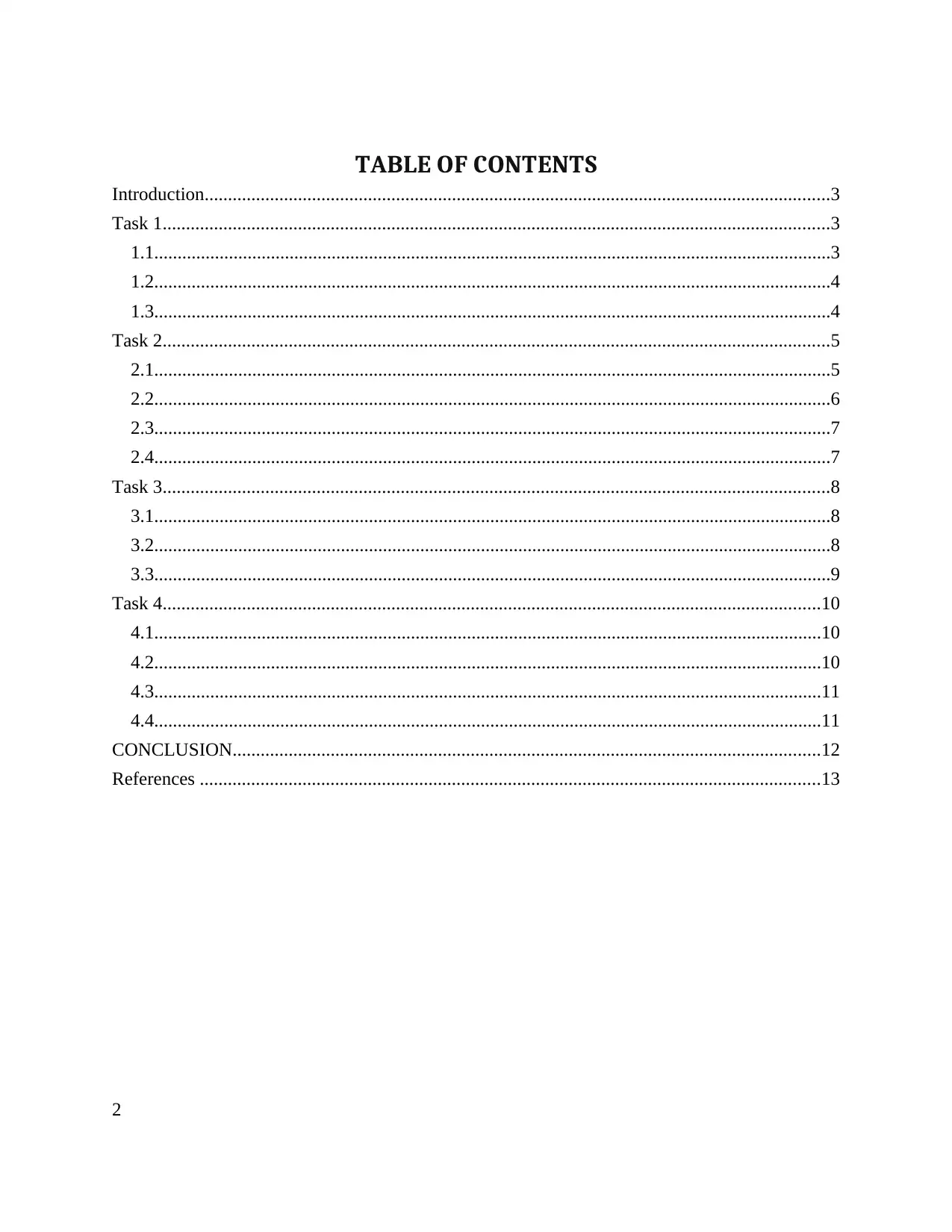
TABLE OF CONTENTS
Introduction......................................................................................................................................3
Task 1...............................................................................................................................................3
1.1.................................................................................................................................................3
1.2.................................................................................................................................................4
1.3.................................................................................................................................................4
Task 2...............................................................................................................................................5
2.1.................................................................................................................................................5
2.2.................................................................................................................................................6
2.3.................................................................................................................................................7
2.4.................................................................................................................................................7
Task 3...............................................................................................................................................8
3.1.................................................................................................................................................8
3.2.................................................................................................................................................8
3.3.................................................................................................................................................9
Task 4.............................................................................................................................................10
4.1...............................................................................................................................................10
4.2...............................................................................................................................................10
4.3...............................................................................................................................................11
4.4...............................................................................................................................................11
CONCLUSION..............................................................................................................................12
References .....................................................................................................................................13
2
Introduction......................................................................................................................................3
Task 1...............................................................................................................................................3
1.1.................................................................................................................................................3
1.2.................................................................................................................................................4
1.3.................................................................................................................................................4
Task 2...............................................................................................................................................5
2.1.................................................................................................................................................5
2.2.................................................................................................................................................6
2.3.................................................................................................................................................7
2.4.................................................................................................................................................7
Task 3...............................................................................................................................................8
3.1.................................................................................................................................................8
3.2.................................................................................................................................................8
3.3.................................................................................................................................................9
Task 4.............................................................................................................................................10
4.1...............................................................................................................................................10
4.2...............................................................................................................................................10
4.3...............................................................................................................................................11
4.4...............................................................................................................................................11
CONCLUSION..............................................................................................................................12
References .....................................................................................................................................13
2
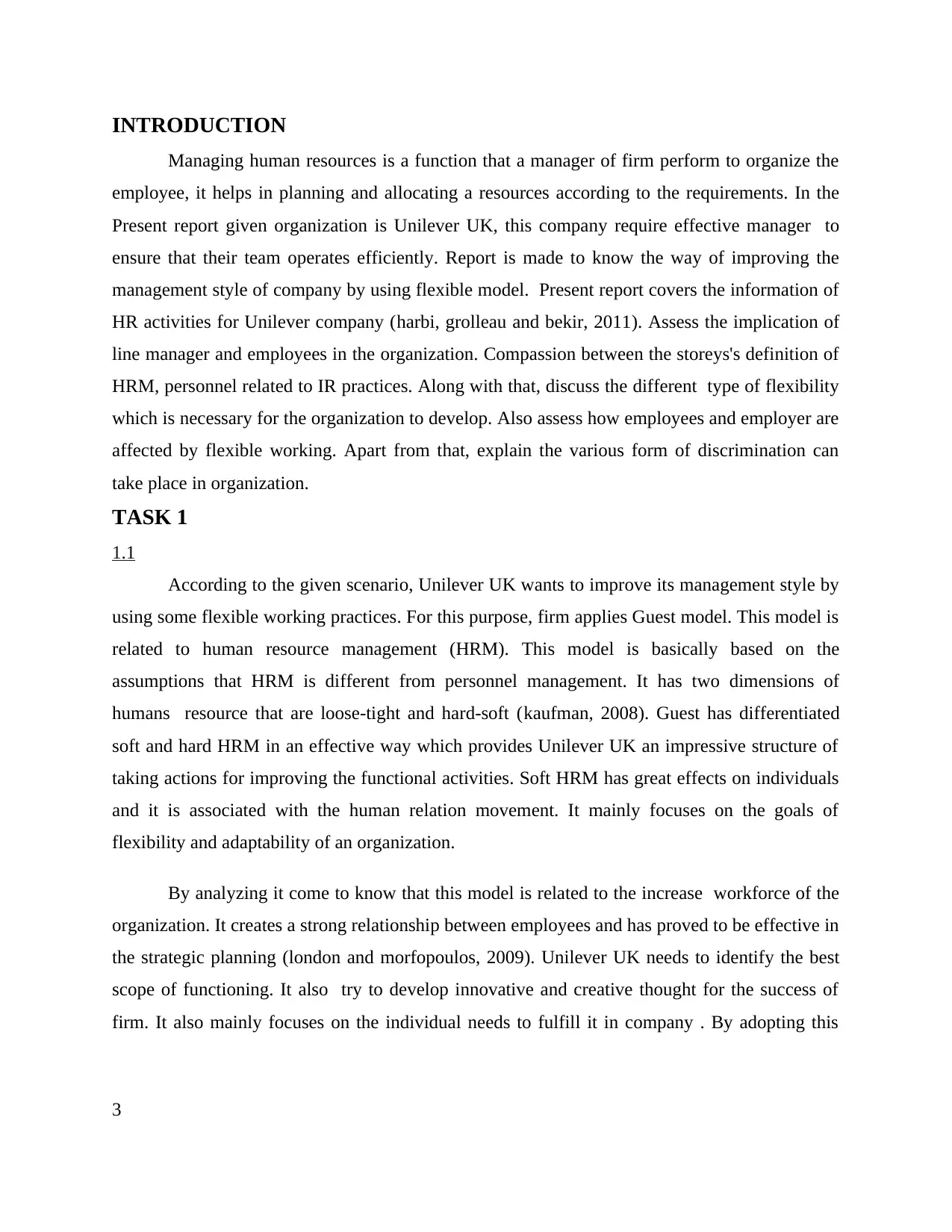
INTRODUCTION
Managing human resources is a function that a manager of firm perform to organize the
employee, it helps in planning and allocating a resources according to the requirements. In the
Present report given organization is Unilever UK, this company require effective manager to
ensure that their team operates efficiently. Report is made to know the way of improving the
management style of company by using flexible model. Present report covers the information of
HR activities for Unilever company (harbi, grolleau and bekir, 2011). Assess the implication of
line manager and employees in the organization. Compassion between the storeys's definition of
HRM, personnel related to IR practices. Along with that, discuss the different type of flexibility
which is necessary for the organization to develop. Also assess how employees and employer are
affected by flexible working. Apart from that, explain the various form of discrimination can
take place in organization.
TASK 1
1.1
According to the given scenario, Unilever UK wants to improve its management style by
using some flexible working practices. For this purpose, firm applies Guest model. This model is
related to human resource management (HRM). This model is basically based on the
assumptions that HRM is different from personnel management. It has two dimensions of
humans resource that are loose-tight and hard-soft (kaufman, 2008). Guest has differentiated
soft and hard HRM in an effective way which provides Unilever UK an impressive structure of
taking actions for improving the functional activities. Soft HRM has great effects on individuals
and it is associated with the human relation movement. It mainly focuses on the goals of
flexibility and adaptability of an organization.
By analyzing it come to know that this model is related to the increase workforce of the
organization. It creates a strong relationship between employees and has proved to be effective in
the strategic planning (london and morfopoulos, 2009). Unilever UK needs to identify the best
scope of functioning. It also try to develop innovative and creative thought for the success of
firm. It also mainly focuses on the individual needs to fulfill it in company . By adopting this
3
Managing human resources is a function that a manager of firm perform to organize the
employee, it helps in planning and allocating a resources according to the requirements. In the
Present report given organization is Unilever UK, this company require effective manager to
ensure that their team operates efficiently. Report is made to know the way of improving the
management style of company by using flexible model. Present report covers the information of
HR activities for Unilever company (harbi, grolleau and bekir, 2011). Assess the implication of
line manager and employees in the organization. Compassion between the storeys's definition of
HRM, personnel related to IR practices. Along with that, discuss the different type of flexibility
which is necessary for the organization to develop. Also assess how employees and employer are
affected by flexible working. Apart from that, explain the various form of discrimination can
take place in organization.
TASK 1
1.1
According to the given scenario, Unilever UK wants to improve its management style by
using some flexible working practices. For this purpose, firm applies Guest model. This model is
related to human resource management (HRM). This model is basically based on the
assumptions that HRM is different from personnel management. It has two dimensions of
humans resource that are loose-tight and hard-soft (kaufman, 2008). Guest has differentiated
soft and hard HRM in an effective way which provides Unilever UK an impressive structure of
taking actions for improving the functional activities. Soft HRM has great effects on individuals
and it is associated with the human relation movement. It mainly focuses on the goals of
flexibility and adaptability of an organization.
By analyzing it come to know that this model is related to the increase workforce of the
organization. It creates a strong relationship between employees and has proved to be effective in
the strategic planning (london and morfopoulos, 2009). Unilever UK needs to identify the best
scope of functioning. It also try to develop innovative and creative thought for the success of
firm. It also mainly focuses on the individual needs to fulfill it in company . By adopting this
3
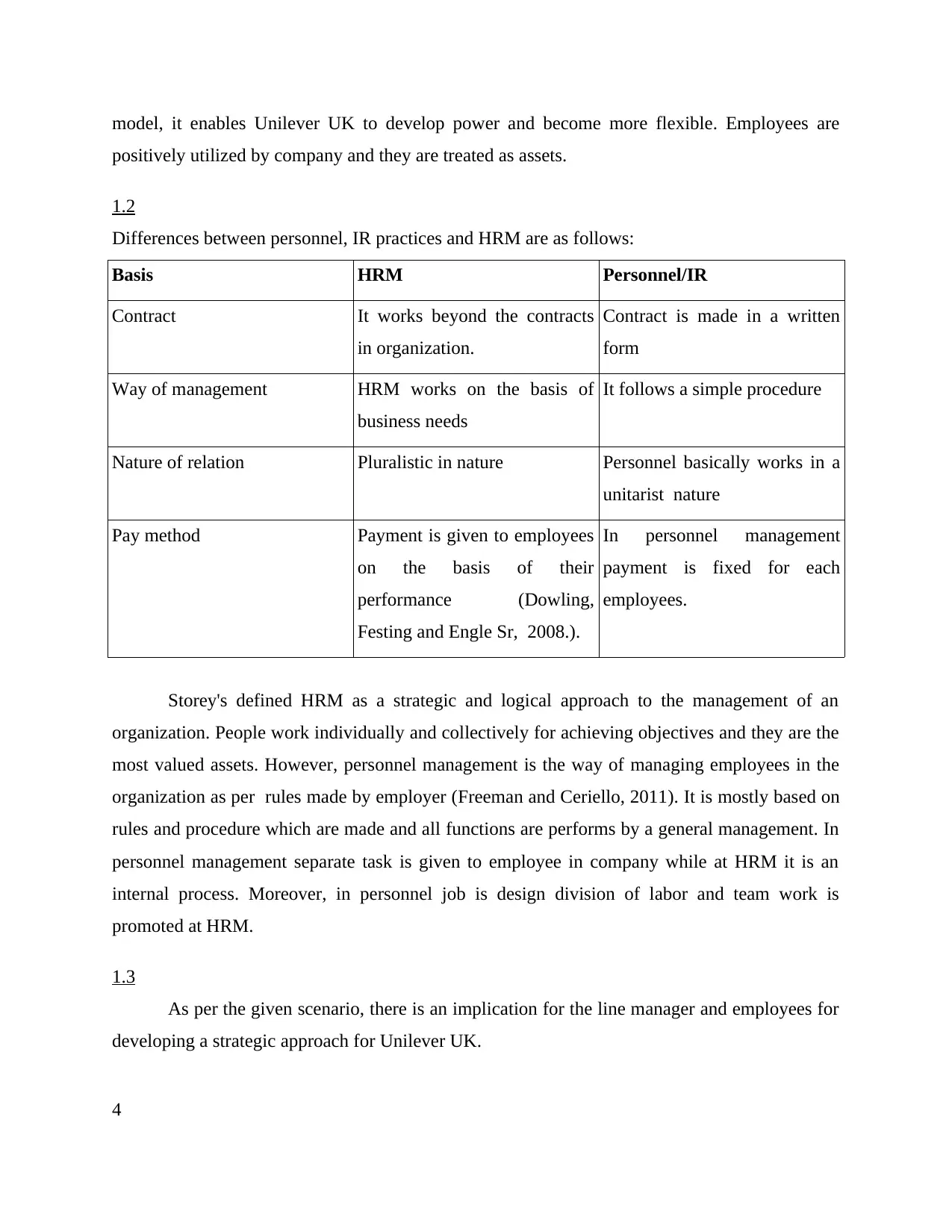
model, it enables Unilever UK to develop power and become more flexible. Employees are
positively utilized by company and they are treated as assets.
1.2
Differences between personnel, IR practices and HRM are as follows:
Basis HRM Personnel/IR
Contract It works beyond the contracts
in organization.
Contract is made in a written
form
Way of management HRM works on the basis of
business needs
It follows a simple procedure
Nature of relation Pluralistic in nature Personnel basically works in a
unitarist nature
Pay method Payment is given to employees
on the basis of their
performance (Dowling,
Festing and Engle Sr, 2008.).
In personnel management
payment is fixed for each
employees.
Storey's defined HRM as a strategic and logical approach to the management of an
organization. People work individually and collectively for achieving objectives and they are the
most valued assets. However, personnel management is the way of managing employees in the
organization as per rules made by employer (Freeman and Ceriello, 2011). It is mostly based on
rules and procedure which are made and all functions are performs by a general management. In
personnel management separate task is given to employee in company while at HRM it is an
internal process. Moreover, in personnel job is design division of labor and team work is
promoted at HRM.
1.3
As per the given scenario, there is an implication for the line manager and employees for
developing a strategic approach for Unilever UK.
4
positively utilized by company and they are treated as assets.
1.2
Differences between personnel, IR practices and HRM are as follows:
Basis HRM Personnel/IR
Contract It works beyond the contracts
in organization.
Contract is made in a written
form
Way of management HRM works on the basis of
business needs
It follows a simple procedure
Nature of relation Pluralistic in nature Personnel basically works in a
unitarist nature
Pay method Payment is given to employees
on the basis of their
performance (Dowling,
Festing and Engle Sr, 2008.).
In personnel management
payment is fixed for each
employees.
Storey's defined HRM as a strategic and logical approach to the management of an
organization. People work individually and collectively for achieving objectives and they are the
most valued assets. However, personnel management is the way of managing employees in the
organization as per rules made by employer (Freeman and Ceriello, 2011). It is mostly based on
rules and procedure which are made and all functions are performs by a general management. In
personnel management separate task is given to employee in company while at HRM it is an
internal process. Moreover, in personnel job is design division of labor and team work is
promoted at HRM.
1.3
As per the given scenario, there is an implication for the line manager and employees for
developing a strategic approach for Unilever UK.
4
Secure Best Marks with AI Grader
Need help grading? Try our AI Grader for instant feedback on your assignments.
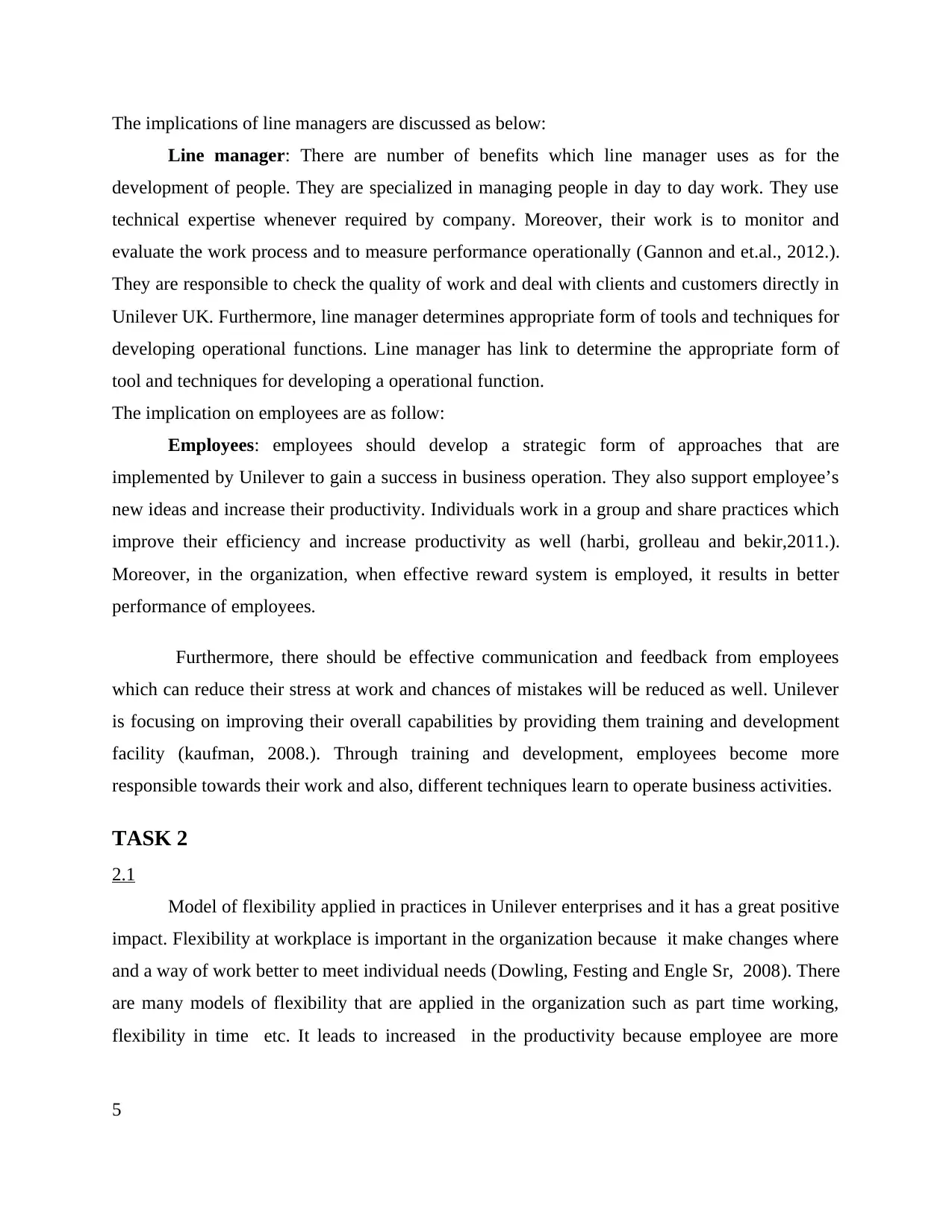
The implications of line managers are discussed as below:
Line manager: There are number of benefits which line manager uses as for the
development of people. They are specialized in managing people in day to day work. They use
technical expertise whenever required by company. Moreover, their work is to monitor and
evaluate the work process and to measure performance operationally (Gannon and et.al., 2012.).
They are responsible to check the quality of work and deal with clients and customers directly in
Unilever UK. Furthermore, line manager determines appropriate form of tools and techniques for
developing operational functions. Line manager has link to determine the appropriate form of
tool and techniques for developing a operational function.
The implication on employees are as follow:
Employees: employees should develop a strategic form of approaches that are
implemented by Unilever to gain a success in business operation. They also support employee’s
new ideas and increase their productivity. Individuals work in a group and share practices which
improve their efficiency and increase productivity as well (harbi, grolleau and bekir,2011.).
Moreover, in the organization, when effective reward system is employed, it results in better
performance of employees.
Furthermore, there should be effective communication and feedback from employees
which can reduce their stress at work and chances of mistakes will be reduced as well. Unilever
is focusing on improving their overall capabilities by providing them training and development
facility (kaufman, 2008.). Through training and development, employees become more
responsible towards their work and also, different techniques learn to operate business activities.
TASK 2
2.1
Model of flexibility applied in practices in Unilever enterprises and it has a great positive
impact. Flexibility at workplace is important in the organization because it make changes where
and a way of work better to meet individual needs (Dowling, Festing and Engle Sr, 2008). There
are many models of flexibility that are applied in the organization such as part time working,
flexibility in time etc. It leads to increased in the productivity because employee are more
5
Line manager: There are number of benefits which line manager uses as for the
development of people. They are specialized in managing people in day to day work. They use
technical expertise whenever required by company. Moreover, their work is to monitor and
evaluate the work process and to measure performance operationally (Gannon and et.al., 2012.).
They are responsible to check the quality of work and deal with clients and customers directly in
Unilever UK. Furthermore, line manager determines appropriate form of tools and techniques for
developing operational functions. Line manager has link to determine the appropriate form of
tool and techniques for developing a operational function.
The implication on employees are as follow:
Employees: employees should develop a strategic form of approaches that are
implemented by Unilever to gain a success in business operation. They also support employee’s
new ideas and increase their productivity. Individuals work in a group and share practices which
improve their efficiency and increase productivity as well (harbi, grolleau and bekir,2011.).
Moreover, in the organization, when effective reward system is employed, it results in better
performance of employees.
Furthermore, there should be effective communication and feedback from employees
which can reduce their stress at work and chances of mistakes will be reduced as well. Unilever
is focusing on improving their overall capabilities by providing them training and development
facility (kaufman, 2008.). Through training and development, employees become more
responsible towards their work and also, different techniques learn to operate business activities.
TASK 2
2.1
Model of flexibility applied in practices in Unilever enterprises and it has a great positive
impact. Flexibility at workplace is important in the organization because it make changes where
and a way of work better to meet individual needs (Dowling, Festing and Engle Sr, 2008). There
are many models of flexibility that are applied in the organization such as part time working,
flexibility in time etc. It leads to increased in the productivity because employee are more
5
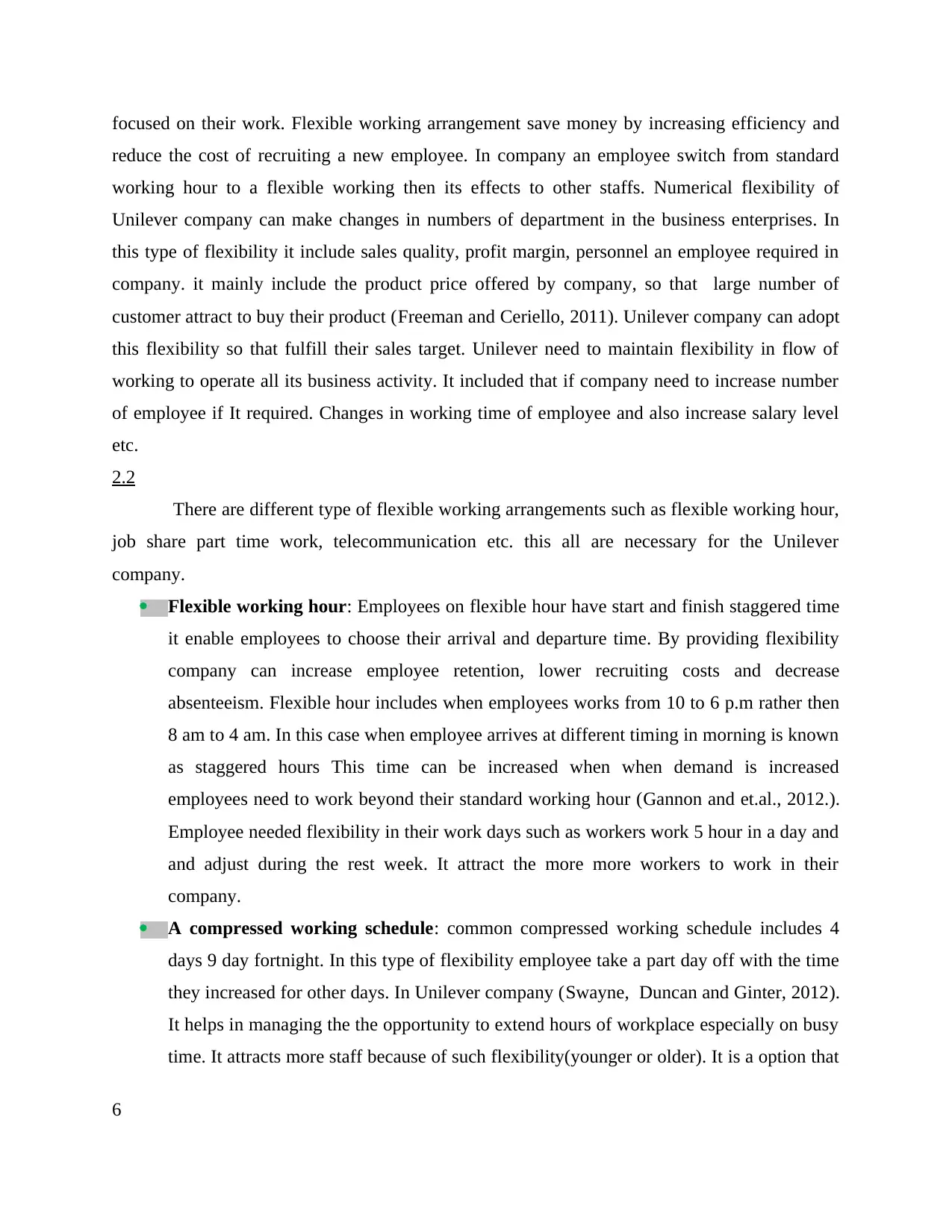
focused on their work. Flexible working arrangement save money by increasing efficiency and
reduce the cost of recruiting a new employee. In company an employee switch from standard
working hour to a flexible working then its effects to other staffs. Numerical flexibility of
Unilever company can make changes in numbers of department in the business enterprises. In
this type of flexibility it include sales quality, profit margin, personnel an employee required in
company. it mainly include the product price offered by company, so that large number of
customer attract to buy their product (Freeman and Ceriello, 2011). Unilever company can adopt
this flexibility so that fulfill their sales target. Unilever need to maintain flexibility in flow of
working to operate all its business activity. It included that if company need to increase number
of employee if It required. Changes in working time of employee and also increase salary level
etc.
2.2
There are different type of flexible working arrangements such as flexible working hour,
job share part time work, telecommunication etc. this all are necessary for the Unilever
company.
Flexible working hour: Employees on flexible hour have start and finish staggered time
it enable employees to choose their arrival and departure time. By providing flexibility
company can increase employee retention, lower recruiting costs and decrease
absenteeism. Flexible hour includes when employees works from 10 to 6 p.m rather then
8 am to 4 am. In this case when employee arrives at different timing in morning is known
as staggered hours This time can be increased when when demand is increased
employees need to work beyond their standard working hour (Gannon and et.al., 2012.).
Employee needed flexibility in their work days such as workers work 5 hour in a day and
and adjust during the rest week. It attract the more more workers to work in their
company.
A compressed working schedule: common compressed working schedule includes 4
days 9 day fortnight. In this type of flexibility employee take a part day off with the time
they increased for other days. In Unilever company (Swayne, Duncan and Ginter, 2012).
It helps in managing the the opportunity to extend hours of workplace especially on busy
time. It attracts more staff because of such flexibility(younger or older). It is a option that
6
reduce the cost of recruiting a new employee. In company an employee switch from standard
working hour to a flexible working then its effects to other staffs. Numerical flexibility of
Unilever company can make changes in numbers of department in the business enterprises. In
this type of flexibility it include sales quality, profit margin, personnel an employee required in
company. it mainly include the product price offered by company, so that large number of
customer attract to buy their product (Freeman and Ceriello, 2011). Unilever company can adopt
this flexibility so that fulfill their sales target. Unilever need to maintain flexibility in flow of
working to operate all its business activity. It included that if company need to increase number
of employee if It required. Changes in working time of employee and also increase salary level
etc.
2.2
There are different type of flexible working arrangements such as flexible working hour,
job share part time work, telecommunication etc. this all are necessary for the Unilever
company.
Flexible working hour: Employees on flexible hour have start and finish staggered time
it enable employees to choose their arrival and departure time. By providing flexibility
company can increase employee retention, lower recruiting costs and decrease
absenteeism. Flexible hour includes when employees works from 10 to 6 p.m rather then
8 am to 4 am. In this case when employee arrives at different timing in morning is known
as staggered hours This time can be increased when when demand is increased
employees need to work beyond their standard working hour (Gannon and et.al., 2012.).
Employee needed flexibility in their work days such as workers work 5 hour in a day and
and adjust during the rest week. It attract the more more workers to work in their
company.
A compressed working schedule: common compressed working schedule includes 4
days 9 day fortnight. In this type of flexibility employee take a part day off with the time
they increased for other days. In Unilever company (Swayne, Duncan and Ginter, 2012).
It helps in managing the the opportunity to extend hours of workplace especially on busy
time. It attracts more staff because of such flexibility(younger or older). It is a option that
6
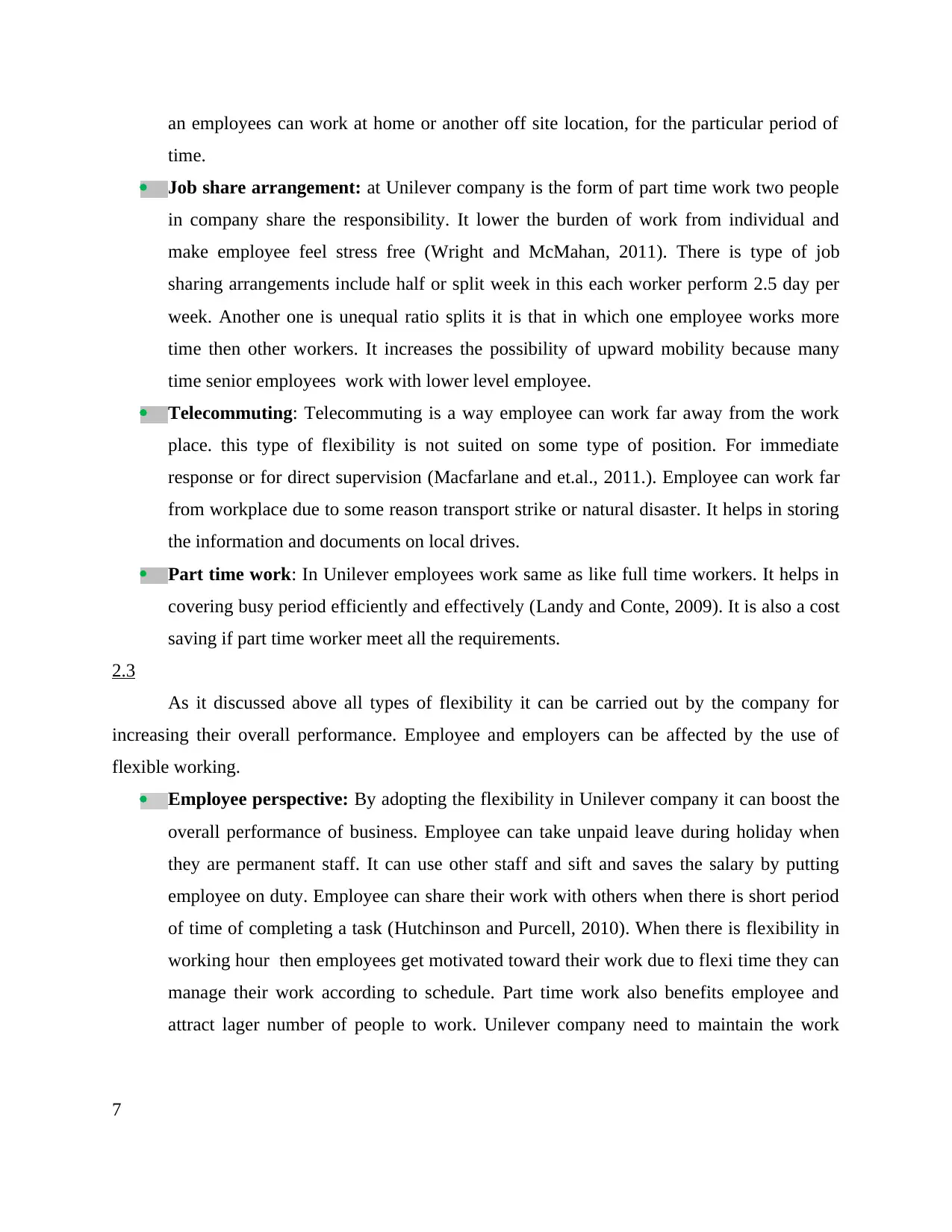
an employees can work at home or another off site location, for the particular period of
time.
Job share arrangement: at Unilever company is the form of part time work two people
in company share the responsibility. It lower the burden of work from individual and
make employee feel stress free (Wright and McMahan, 2011). There is type of job
sharing arrangements include half or split week in this each worker perform 2.5 day per
week. Another one is unequal ratio splits it is that in which one employee works more
time then other workers. It increases the possibility of upward mobility because many
time senior employees work with lower level employee.
Telecommuting: Telecommuting is a way employee can work far away from the work
place. this type of flexibility is not suited on some type of position. For immediate
response or for direct supervision (Macfarlane and et.al., 2011.). Employee can work far
from workplace due to some reason transport strike or natural disaster. It helps in storing
the information and documents on local drives.
Part time work: In Unilever employees work same as like full time workers. It helps in
covering busy period efficiently and effectively (Landy and Conte, 2009). It is also a cost
saving if part time worker meet all the requirements.
2.3
As it discussed above all types of flexibility it can be carried out by the company for
increasing their overall performance. Employee and employers can be affected by the use of
flexible working.
Employee perspective: By adopting the flexibility in Unilever company it can boost the
overall performance of business. Employee can take unpaid leave during holiday when
they are permanent staff. It can use other staff and sift and saves the salary by putting
employee on duty. Employee can share their work with others when there is short period
of time of completing a task (Hutchinson and Purcell, 2010). When there is flexibility in
working hour then employees get motivated toward their work due to flexi time they can
manage their work according to schedule. Part time work also benefits employee and
attract lager number of people to work. Unilever company need to maintain the work
7
time.
Job share arrangement: at Unilever company is the form of part time work two people
in company share the responsibility. It lower the burden of work from individual and
make employee feel stress free (Wright and McMahan, 2011). There is type of job
sharing arrangements include half or split week in this each worker perform 2.5 day per
week. Another one is unequal ratio splits it is that in which one employee works more
time then other workers. It increases the possibility of upward mobility because many
time senior employees work with lower level employee.
Telecommuting: Telecommuting is a way employee can work far away from the work
place. this type of flexibility is not suited on some type of position. For immediate
response or for direct supervision (Macfarlane and et.al., 2011.). Employee can work far
from workplace due to some reason transport strike or natural disaster. It helps in storing
the information and documents on local drives.
Part time work: In Unilever employees work same as like full time workers. It helps in
covering busy period efficiently and effectively (Landy and Conte, 2009). It is also a cost
saving if part time worker meet all the requirements.
2.3
As it discussed above all types of flexibility it can be carried out by the company for
increasing their overall performance. Employee and employers can be affected by the use of
flexible working.
Employee perspective: By adopting the flexibility in Unilever company it can boost the
overall performance of business. Employee can take unpaid leave during holiday when
they are permanent staff. It can use other staff and sift and saves the salary by putting
employee on duty. Employee can share their work with others when there is short period
of time of completing a task (Hutchinson and Purcell, 2010). When there is flexibility in
working hour then employees get motivated toward their work due to flexi time they can
manage their work according to schedule. Part time work also benefits employee and
attract lager number of people to work. Unilever company need to maintain the work
7
Paraphrase This Document
Need a fresh take? Get an instant paraphrase of this document with our AI Paraphraser
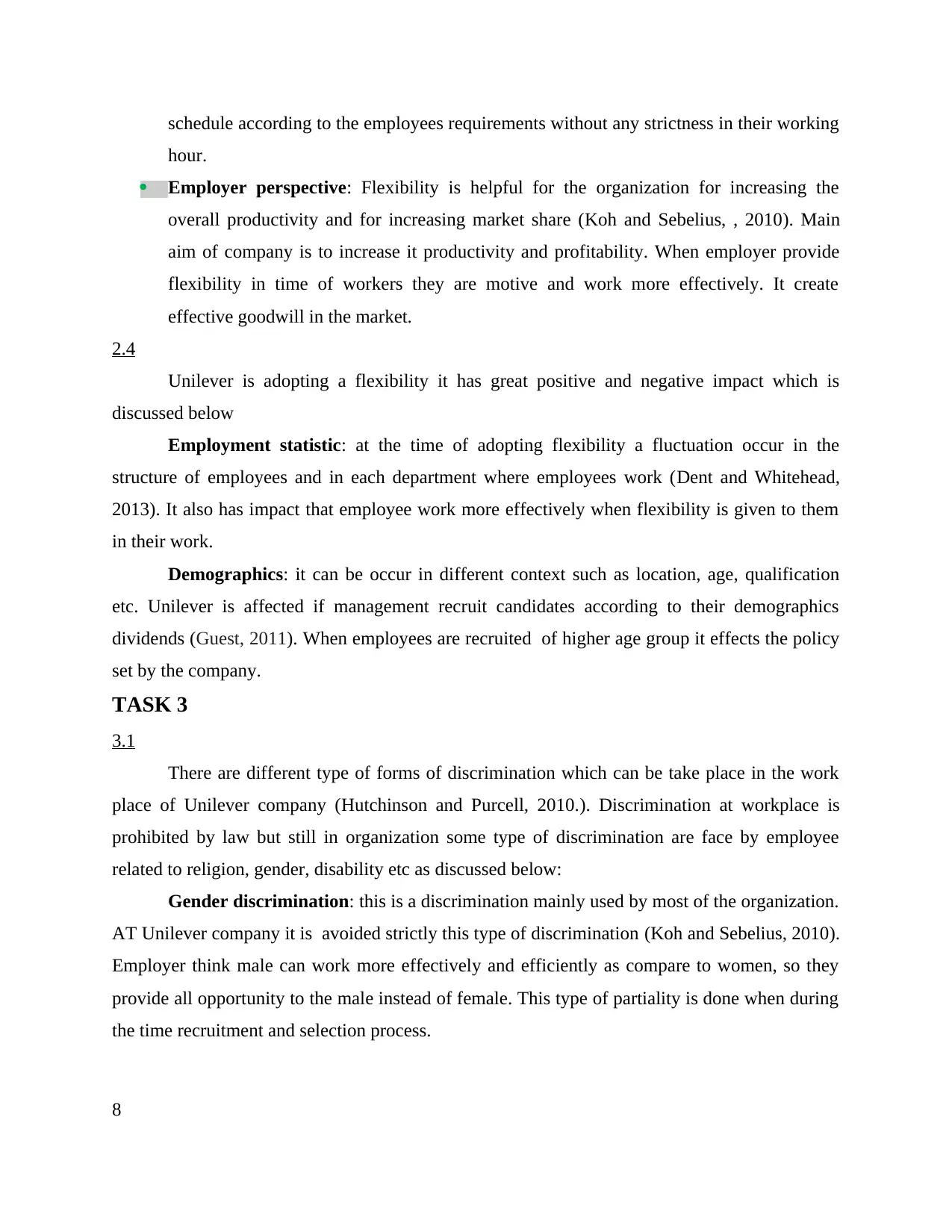
schedule according to the employees requirements without any strictness in their working
hour.
Employer perspective: Flexibility is helpful for the organization for increasing the
overall productivity and for increasing market share (Koh and Sebelius, , 2010). Main
aim of company is to increase it productivity and profitability. When employer provide
flexibility in time of workers they are motive and work more effectively. It create
effective goodwill in the market.
2.4
Unilever is adopting a flexibility it has great positive and negative impact which is
discussed below
Employment statistic: at the time of adopting flexibility a fluctuation occur in the
structure of employees and in each department where employees work (Dent and Whitehead,
2013). It also has impact that employee work more effectively when flexibility is given to them
in their work.
Demographics: it can be occur in different context such as location, age, qualification
etc. Unilever is affected if management recruit candidates according to their demographics
dividends (Guest, 2011). When employees are recruited of higher age group it effects the policy
set by the company.
TASK 3
3.1
There are different type of forms of discrimination which can be take place in the work
place of Unilever company (Hutchinson and Purcell, 2010.). Discrimination at workplace is
prohibited by law but still in organization some type of discrimination are face by employee
related to religion, gender, disability etc as discussed below:
Gender discrimination: this is a discrimination mainly used by most of the organization.
AT Unilever company it is avoided strictly this type of discrimination (Koh and Sebelius, 2010).
Employer think male can work more effectively and efficiently as compare to women, so they
provide all opportunity to the male instead of female. This type of partiality is done when during
the time recruitment and selection process.
8
hour.
Employer perspective: Flexibility is helpful for the organization for increasing the
overall productivity and for increasing market share (Koh and Sebelius, , 2010). Main
aim of company is to increase it productivity and profitability. When employer provide
flexibility in time of workers they are motive and work more effectively. It create
effective goodwill in the market.
2.4
Unilever is adopting a flexibility it has great positive and negative impact which is
discussed below
Employment statistic: at the time of adopting flexibility a fluctuation occur in the
structure of employees and in each department where employees work (Dent and Whitehead,
2013). It also has impact that employee work more effectively when flexibility is given to them
in their work.
Demographics: it can be occur in different context such as location, age, qualification
etc. Unilever is affected if management recruit candidates according to their demographics
dividends (Guest, 2011). When employees are recruited of higher age group it effects the policy
set by the company.
TASK 3
3.1
There are different type of forms of discrimination which can be take place in the work
place of Unilever company (Hutchinson and Purcell, 2010.). Discrimination at workplace is
prohibited by law but still in organization some type of discrimination are face by employee
related to religion, gender, disability etc as discussed below:
Gender discrimination: this is a discrimination mainly used by most of the organization.
AT Unilever company it is avoided strictly this type of discrimination (Koh and Sebelius, 2010).
Employer think male can work more effectively and efficiently as compare to women, so they
provide all opportunity to the male instead of female. This type of partiality is done when during
the time recruitment and selection process.
8
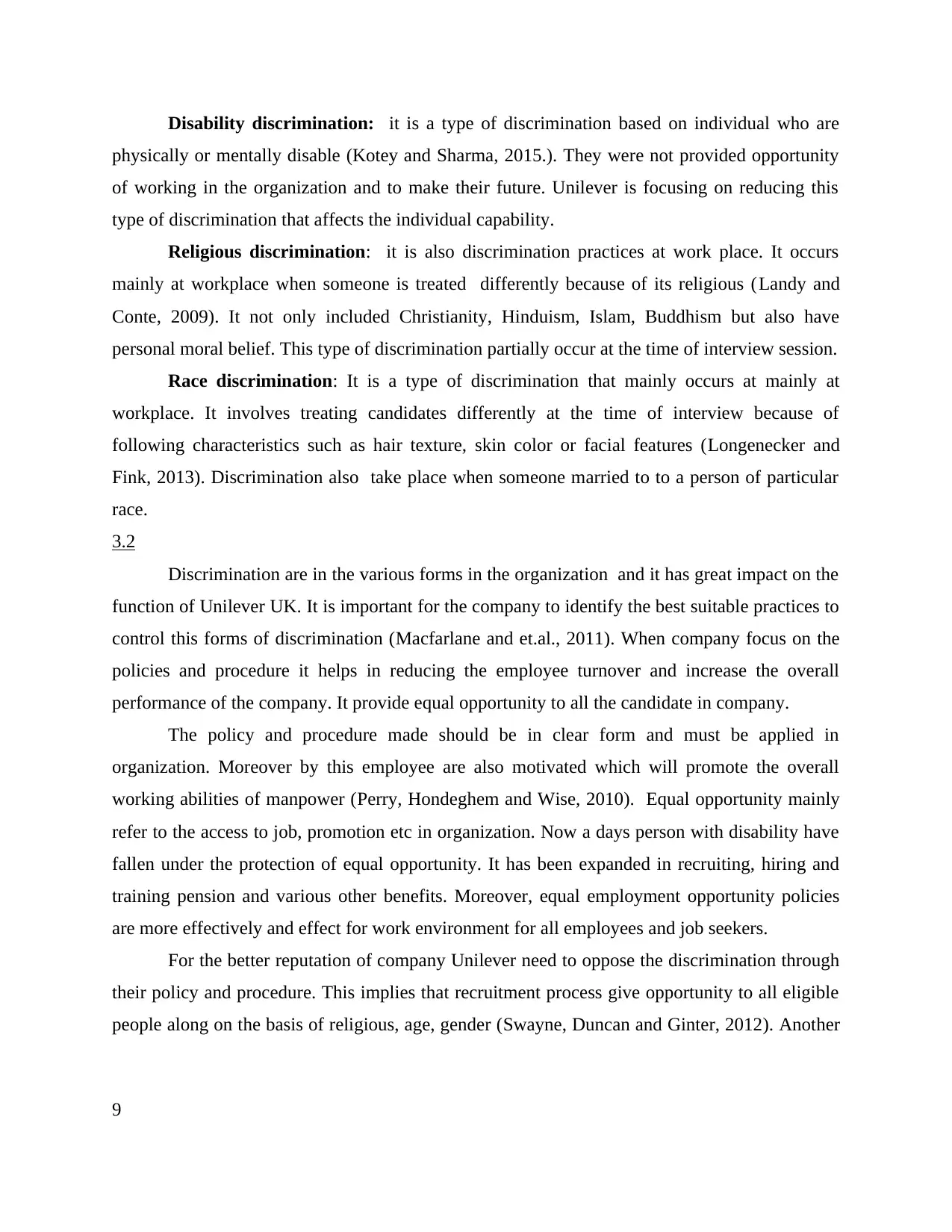
Disability discrimination: it is a type of discrimination based on individual who are
physically or mentally disable (Kotey and Sharma, 2015.). They were not provided opportunity
of working in the organization and to make their future. Unilever is focusing on reducing this
type of discrimination that affects the individual capability.
Religious discrimination: it is also discrimination practices at work place. It occurs
mainly at workplace when someone is treated differently because of its religious (Landy and
Conte, 2009). It not only included Christianity, Hinduism, Islam, Buddhism but also have
personal moral belief. This type of discrimination partially occur at the time of interview session.
Race discrimination: It is a type of discrimination that mainly occurs at mainly at
workplace. It involves treating candidates differently at the time of interview because of
following characteristics such as hair texture, skin color or facial features (Longenecker and
Fink, 2013). Discrimination also take place when someone married to to a person of particular
race.
3.2
Discrimination are in the various forms in the organization and it has great impact on the
function of Unilever UK. It is important for the company to identify the best suitable practices to
control this forms of discrimination (Macfarlane and et.al., 2011). When company focus on the
policies and procedure it helps in reducing the employee turnover and increase the overall
performance of the company. It provide equal opportunity to all the candidate in company.
The policy and procedure made should be in clear form and must be applied in
organization. Moreover by this employee are also motivated which will promote the overall
working abilities of manpower (Perry, Hondeghem and Wise, 2010). Equal opportunity mainly
refer to the access to job, promotion etc in organization. Now a days person with disability have
fallen under the protection of equal opportunity. It has been expanded in recruiting, hiring and
training pension and various other benefits. Moreover, equal employment opportunity policies
are more effectively and effect for work environment for all employees and job seekers.
For the better reputation of company Unilever need to oppose the discrimination through
their policy and procedure. This implies that recruitment process give opportunity to all eligible
people along on the basis of religious, age, gender (Swayne, Duncan and Ginter, 2012). Another
9
physically or mentally disable (Kotey and Sharma, 2015.). They were not provided opportunity
of working in the organization and to make their future. Unilever is focusing on reducing this
type of discrimination that affects the individual capability.
Religious discrimination: it is also discrimination practices at work place. It occurs
mainly at workplace when someone is treated differently because of its religious (Landy and
Conte, 2009). It not only included Christianity, Hinduism, Islam, Buddhism but also have
personal moral belief. This type of discrimination partially occur at the time of interview session.
Race discrimination: It is a type of discrimination that mainly occurs at mainly at
workplace. It involves treating candidates differently at the time of interview because of
following characteristics such as hair texture, skin color or facial features (Longenecker and
Fink, 2013). Discrimination also take place when someone married to to a person of particular
race.
3.2
Discrimination are in the various forms in the organization and it has great impact on the
function of Unilever UK. It is important for the company to identify the best suitable practices to
control this forms of discrimination (Macfarlane and et.al., 2011). When company focus on the
policies and procedure it helps in reducing the employee turnover and increase the overall
performance of the company. It provide equal opportunity to all the candidate in company.
The policy and procedure made should be in clear form and must be applied in
organization. Moreover by this employee are also motivated which will promote the overall
working abilities of manpower (Perry, Hondeghem and Wise, 2010). Equal opportunity mainly
refer to the access to job, promotion etc in organization. Now a days person with disability have
fallen under the protection of equal opportunity. It has been expanded in recruiting, hiring and
training pension and various other benefits. Moreover, equal employment opportunity policies
are more effectively and effect for work environment for all employees and job seekers.
For the better reputation of company Unilever need to oppose the discrimination through
their policy and procedure. This implies that recruitment process give opportunity to all eligible
people along on the basis of religious, age, gender (Swayne, Duncan and Ginter, 2012). Another
9
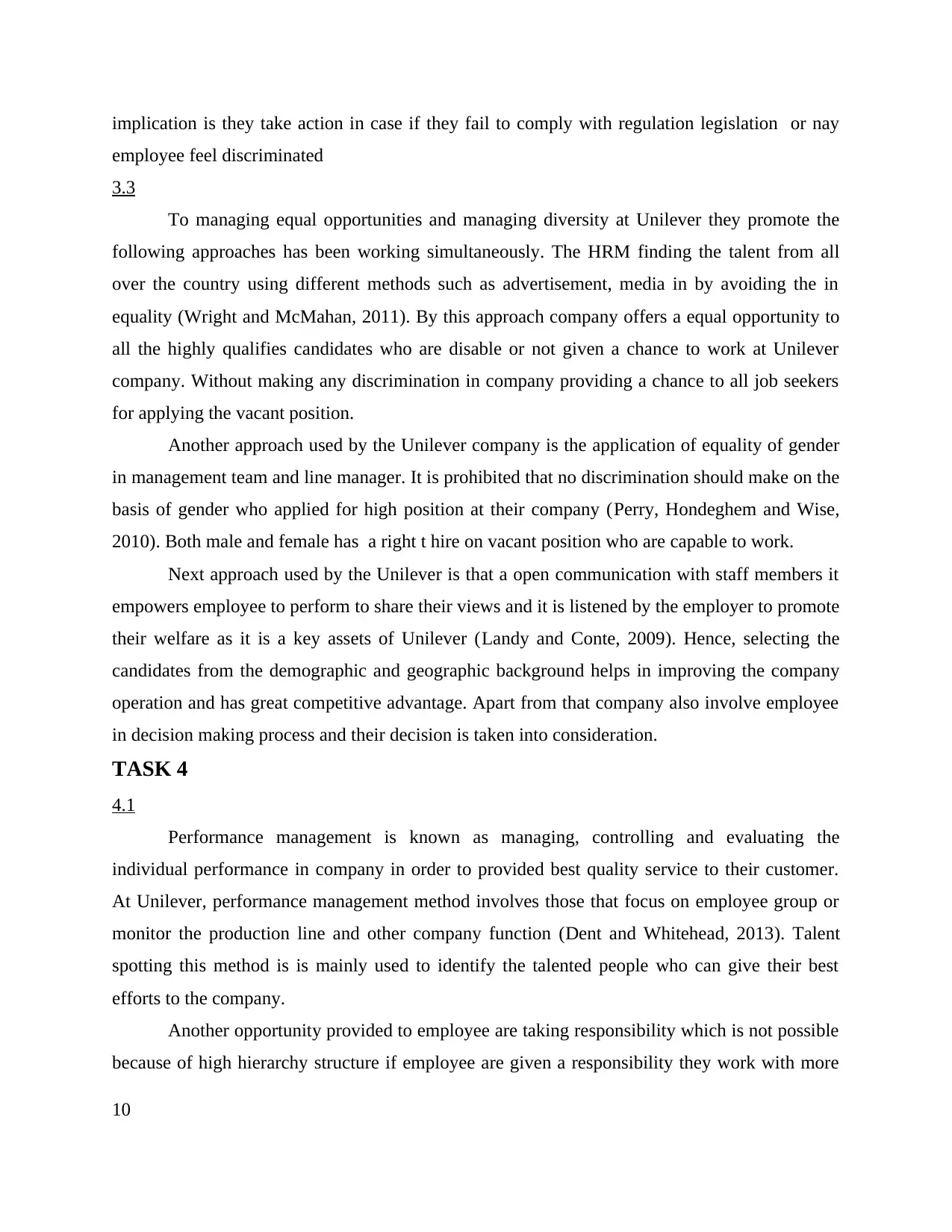
implication is they take action in case if they fail to comply with regulation legislation or nay
employee feel discriminated
3.3
To managing equal opportunities and managing diversity at Unilever they promote the
following approaches has been working simultaneously. The HRM finding the talent from all
over the country using different methods such as advertisement, media in by avoiding the in
equality (Wright and McMahan, 2011). By this approach company offers a equal opportunity to
all the highly qualifies candidates who are disable or not given a chance to work at Unilever
company. Without making any discrimination in company providing a chance to all job seekers
for applying the vacant position.
Another approach used by the Unilever company is the application of equality of gender
in management team and line manager. It is prohibited that no discrimination should make on the
basis of gender who applied for high position at their company (Perry, Hondeghem and Wise,
2010). Both male and female has a right t hire on vacant position who are capable to work.
Next approach used by the Unilever is that a open communication with staff members it
empowers employee to perform to share their views and it is listened by the employer to promote
their welfare as it is a key assets of Unilever (Landy and Conte, 2009). Hence, selecting the
candidates from the demographic and geographic background helps in improving the company
operation and has great competitive advantage. Apart from that company also involve employee
in decision making process and their decision is taken into consideration.
TASK 4
4.1
Performance management is known as managing, controlling and evaluating the
individual performance in company in order to provided best quality service to their customer.
At Unilever, performance management method involves those that focus on employee group or
monitor the production line and other company function (Dent and Whitehead, 2013). Talent
spotting this method is is mainly used to identify the talented people who can give their best
efforts to the company.
Another opportunity provided to employee are taking responsibility which is not possible
because of high hierarchy structure if employee are given a responsibility they work with more
10
employee feel discriminated
3.3
To managing equal opportunities and managing diversity at Unilever they promote the
following approaches has been working simultaneously. The HRM finding the talent from all
over the country using different methods such as advertisement, media in by avoiding the in
equality (Wright and McMahan, 2011). By this approach company offers a equal opportunity to
all the highly qualifies candidates who are disable or not given a chance to work at Unilever
company. Without making any discrimination in company providing a chance to all job seekers
for applying the vacant position.
Another approach used by the Unilever company is the application of equality of gender
in management team and line manager. It is prohibited that no discrimination should make on the
basis of gender who applied for high position at their company (Perry, Hondeghem and Wise,
2010). Both male and female has a right t hire on vacant position who are capable to work.
Next approach used by the Unilever is that a open communication with staff members it
empowers employee to perform to share their views and it is listened by the employer to promote
their welfare as it is a key assets of Unilever (Landy and Conte, 2009). Hence, selecting the
candidates from the demographic and geographic background helps in improving the company
operation and has great competitive advantage. Apart from that company also involve employee
in decision making process and their decision is taken into consideration.
TASK 4
4.1
Performance management is known as managing, controlling and evaluating the
individual performance in company in order to provided best quality service to their customer.
At Unilever, performance management method involves those that focus on employee group or
monitor the production line and other company function (Dent and Whitehead, 2013). Talent
spotting this method is is mainly used to identify the talented people who can give their best
efforts to the company.
Another opportunity provided to employee are taking responsibility which is not possible
because of high hierarchy structure if employee are given a responsibility they work with more
10
Secure Best Marks with AI Grader
Need help grading? Try our AI Grader for instant feedback on your assignments.
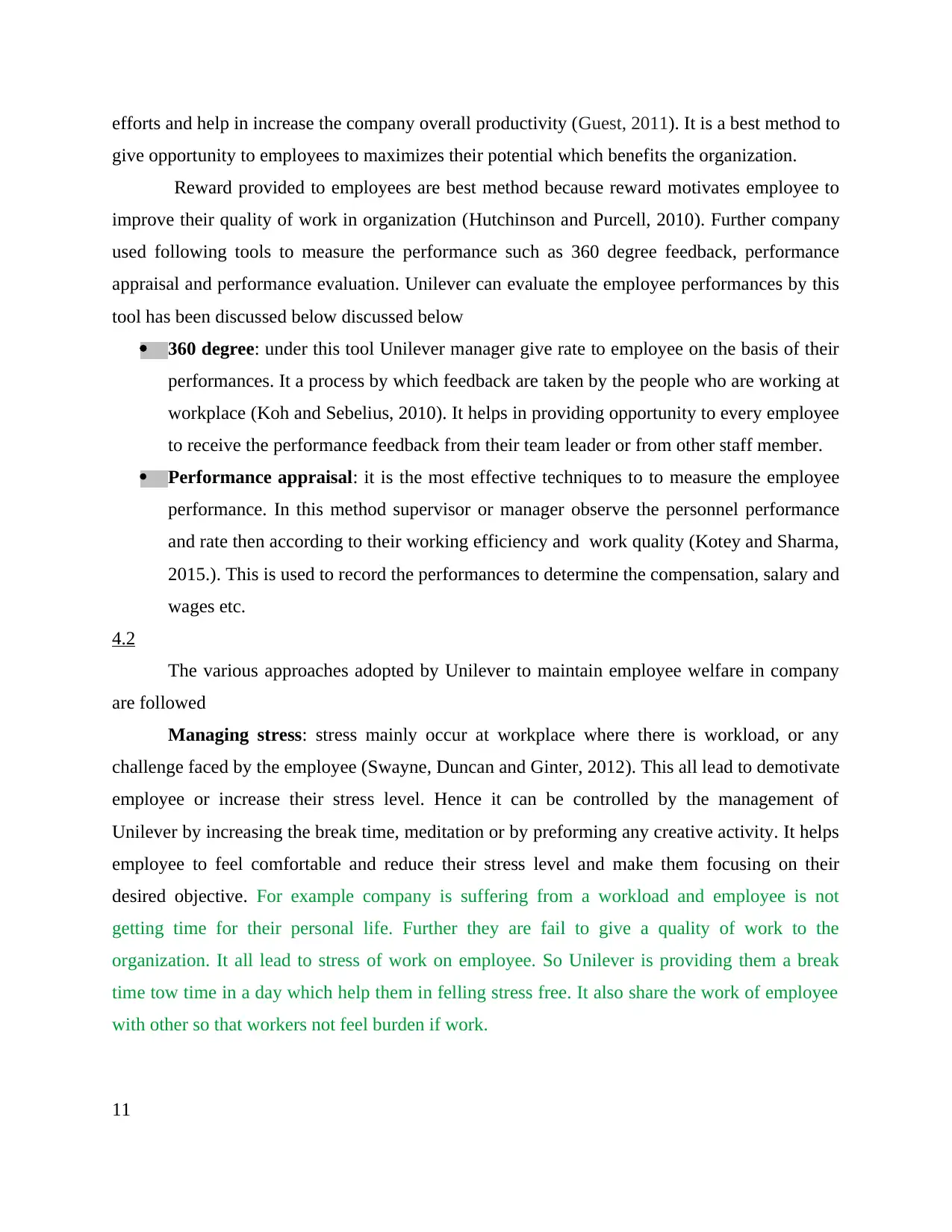
efforts and help in increase the company overall productivity (Guest, 2011). It is a best method to
give opportunity to employees to maximizes their potential which benefits the organization.
Reward provided to employees are best method because reward motivates employee to
improve their quality of work in organization (Hutchinson and Purcell, 2010). Further company
used following tools to measure the performance such as 360 degree feedback, performance
appraisal and performance evaluation. Unilever can evaluate the employee performances by this
tool has been discussed below discussed below
360 degree: under this tool Unilever manager give rate to employee on the basis of their
performances. It a process by which feedback are taken by the people who are working at
workplace (Koh and Sebelius, 2010). It helps in providing opportunity to every employee
to receive the performance feedback from their team leader or from other staff member.
Performance appraisal: it is the most effective techniques to to measure the employee
performance. In this method supervisor or manager observe the personnel performance
and rate then according to their working efficiency and work quality (Kotey and Sharma,
2015.). This is used to record the performances to determine the compensation, salary and
wages etc.
4.2
The various approaches adopted by Unilever to maintain employee welfare in company
are followed
Managing stress: stress mainly occur at workplace where there is workload, or any
challenge faced by the employee (Swayne, Duncan and Ginter, 2012). This all lead to demotivate
employee or increase their stress level. Hence it can be controlled by the management of
Unilever by increasing the break time, meditation or by preforming any creative activity. It helps
employee to feel comfortable and reduce their stress level and make them focusing on their
desired objective. For example company is suffering from a workload and employee is not
getting time for their personal life. Further they are fail to give a quality of work to the
organization. It all lead to stress of work on employee. So Unilever is providing them a break
time tow time in a day which help them in felling stress free. It also share the work of employee
with other so that workers not feel burden if work.
11
give opportunity to employees to maximizes their potential which benefits the organization.
Reward provided to employees are best method because reward motivates employee to
improve their quality of work in organization (Hutchinson and Purcell, 2010). Further company
used following tools to measure the performance such as 360 degree feedback, performance
appraisal and performance evaluation. Unilever can evaluate the employee performances by this
tool has been discussed below discussed below
360 degree: under this tool Unilever manager give rate to employee on the basis of their
performances. It a process by which feedback are taken by the people who are working at
workplace (Koh and Sebelius, 2010). It helps in providing opportunity to every employee
to receive the performance feedback from their team leader or from other staff member.
Performance appraisal: it is the most effective techniques to to measure the employee
performance. In this method supervisor or manager observe the personnel performance
and rate then according to their working efficiency and work quality (Kotey and Sharma,
2015.). This is used to record the performances to determine the compensation, salary and
wages etc.
4.2
The various approaches adopted by Unilever to maintain employee welfare in company
are followed
Managing stress: stress mainly occur at workplace where there is workload, or any
challenge faced by the employee (Swayne, Duncan and Ginter, 2012). This all lead to demotivate
employee or increase their stress level. Hence it can be controlled by the management of
Unilever by increasing the break time, meditation or by preforming any creative activity. It helps
employee to feel comfortable and reduce their stress level and make them focusing on their
desired objective. For example company is suffering from a workload and employee is not
getting time for their personal life. Further they are fail to give a quality of work to the
organization. It all lead to stress of work on employee. So Unilever is providing them a break
time tow time in a day which help them in felling stress free. It also share the work of employee
with other so that workers not feel burden if work.
11
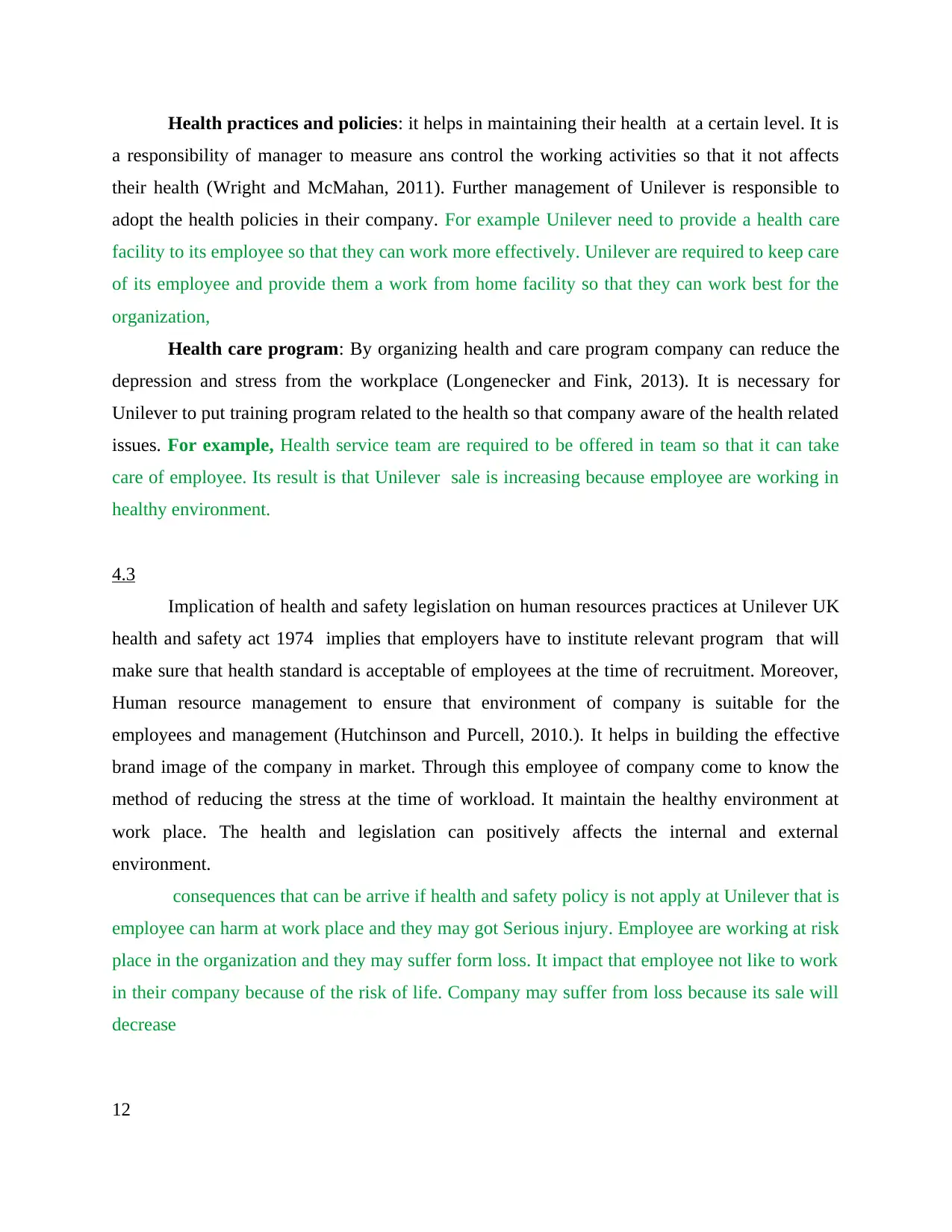
Health practices and policies: it helps in maintaining their health at a certain level. It is
a responsibility of manager to measure ans control the working activities so that it not affects
their health (Wright and McMahan, 2011). Further management of Unilever is responsible to
adopt the health policies in their company. For example Unilever need to provide a health care
facility to its employee so that they can work more effectively. Unilever are required to keep care
of its employee and provide them a work from home facility so that they can work best for the
organization,
Health care program: By organizing health and care program company can reduce the
depression and stress from the workplace (Longenecker and Fink, 2013). It is necessary for
Unilever to put training program related to the health so that company aware of the health related
issues. For example, Health service team are required to be offered in team so that it can take
care of employee. Its result is that Unilever sale is increasing because employee are working in
healthy environment.
4.3
Implication of health and safety legislation on human resources practices at Unilever UK
health and safety act 1974 implies that employers have to institute relevant program that will
make sure that health standard is acceptable of employees at the time of recruitment. Moreover,
Human resource management to ensure that environment of company is suitable for the
employees and management (Hutchinson and Purcell, 2010.). It helps in building the effective
brand image of the company in market. Through this employee of company come to know the
method of reducing the stress at the time of workload. It maintain the healthy environment at
work place. The health and legislation can positively affects the internal and external
environment.
consequences that can be arrive if health and safety policy is not apply at Unilever that is
employee can harm at work place and they may got Serious injury. Employee are working at risk
place in the organization and they may suffer form loss. It impact that employee not like to work
in their company because of the risk of life. Company may suffer from loss because its sale will
decrease
12
a responsibility of manager to measure ans control the working activities so that it not affects
their health (Wright and McMahan, 2011). Further management of Unilever is responsible to
adopt the health policies in their company. For example Unilever need to provide a health care
facility to its employee so that they can work more effectively. Unilever are required to keep care
of its employee and provide them a work from home facility so that they can work best for the
organization,
Health care program: By organizing health and care program company can reduce the
depression and stress from the workplace (Longenecker and Fink, 2013). It is necessary for
Unilever to put training program related to the health so that company aware of the health related
issues. For example, Health service team are required to be offered in team so that it can take
care of employee. Its result is that Unilever sale is increasing because employee are working in
healthy environment.
4.3
Implication of health and safety legislation on human resources practices at Unilever UK
health and safety act 1974 implies that employers have to institute relevant program that will
make sure that health standard is acceptable of employees at the time of recruitment. Moreover,
Human resource management to ensure that environment of company is suitable for the
employees and management (Hutchinson and Purcell, 2010.). It helps in building the effective
brand image of the company in market. Through this employee of company come to know the
method of reducing the stress at the time of workload. It maintain the healthy environment at
work place. The health and legislation can positively affects the internal and external
environment.
consequences that can be arrive if health and safety policy is not apply at Unilever that is
employee can harm at work place and they may got Serious injury. Employee are working at risk
place in the organization and they may suffer form loss. It impact that employee not like to work
in their company because of the risk of life. Company may suffer from loss because its sale will
decrease
12
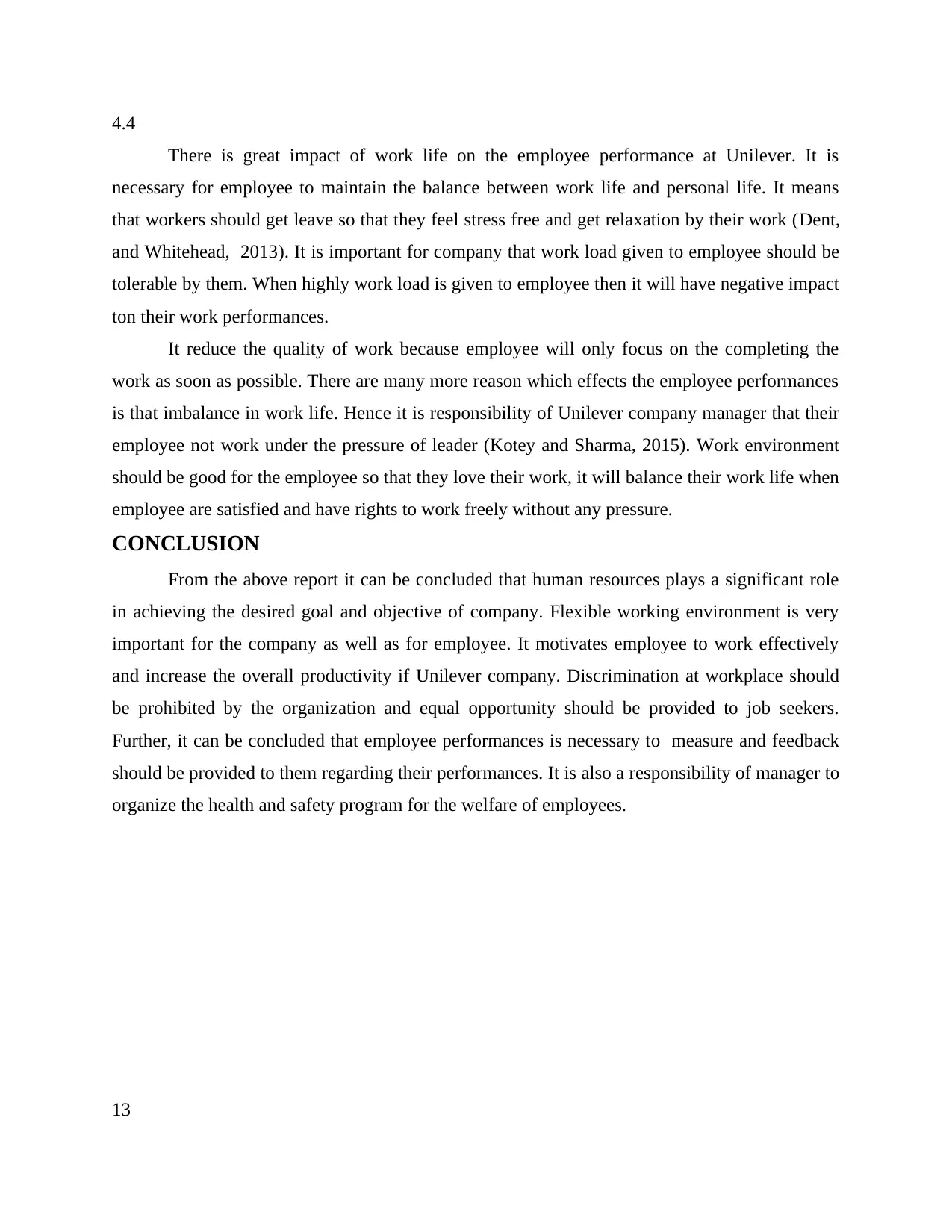
4.4
There is great impact of work life on the employee performance at Unilever. It is
necessary for employee to maintain the balance between work life and personal life. It means
that workers should get leave so that they feel stress free and get relaxation by their work (Dent,
and Whitehead, 2013). It is important for company that work load given to employee should be
tolerable by them. When highly work load is given to employee then it will have negative impact
ton their work performances.
It reduce the quality of work because employee will only focus on the completing the
work as soon as possible. There are many more reason which effects the employee performances
is that imbalance in work life. Hence it is responsibility of Unilever company manager that their
employee not work under the pressure of leader (Kotey and Sharma, 2015). Work environment
should be good for the employee so that they love their work, it will balance their work life when
employee are satisfied and have rights to work freely without any pressure.
CONCLUSION
From the above report it can be concluded that human resources plays a significant role
in achieving the desired goal and objective of company. Flexible working environment is very
important for the company as well as for employee. It motivates employee to work effectively
and increase the overall productivity if Unilever company. Discrimination at workplace should
be prohibited by the organization and equal opportunity should be provided to job seekers.
Further, it can be concluded that employee performances is necessary to measure and feedback
should be provided to them regarding their performances. It is also a responsibility of manager to
organize the health and safety program for the welfare of employees.
13
There is great impact of work life on the employee performance at Unilever. It is
necessary for employee to maintain the balance between work life and personal life. It means
that workers should get leave so that they feel stress free and get relaxation by their work (Dent,
and Whitehead, 2013). It is important for company that work load given to employee should be
tolerable by them. When highly work load is given to employee then it will have negative impact
ton their work performances.
It reduce the quality of work because employee will only focus on the completing the
work as soon as possible. There are many more reason which effects the employee performances
is that imbalance in work life. Hence it is responsibility of Unilever company manager that their
employee not work under the pressure of leader (Kotey and Sharma, 2015). Work environment
should be good for the employee so that they love their work, it will balance their work life when
employee are satisfied and have rights to work freely without any pressure.
CONCLUSION
From the above report it can be concluded that human resources plays a significant role
in achieving the desired goal and objective of company. Flexible working environment is very
important for the company as well as for employee. It motivates employee to work effectively
and increase the overall productivity if Unilever company. Discrimination at workplace should
be prohibited by the organization and equal opportunity should be provided to job seekers.
Further, it can be concluded that employee performances is necessary to measure and feedback
should be provided to them regarding their performances. It is also a responsibility of manager to
organize the health and safety program for the welfare of employees.
13
Paraphrase This Document
Need a fresh take? Get an instant paraphrase of this document with our AI Paraphraser
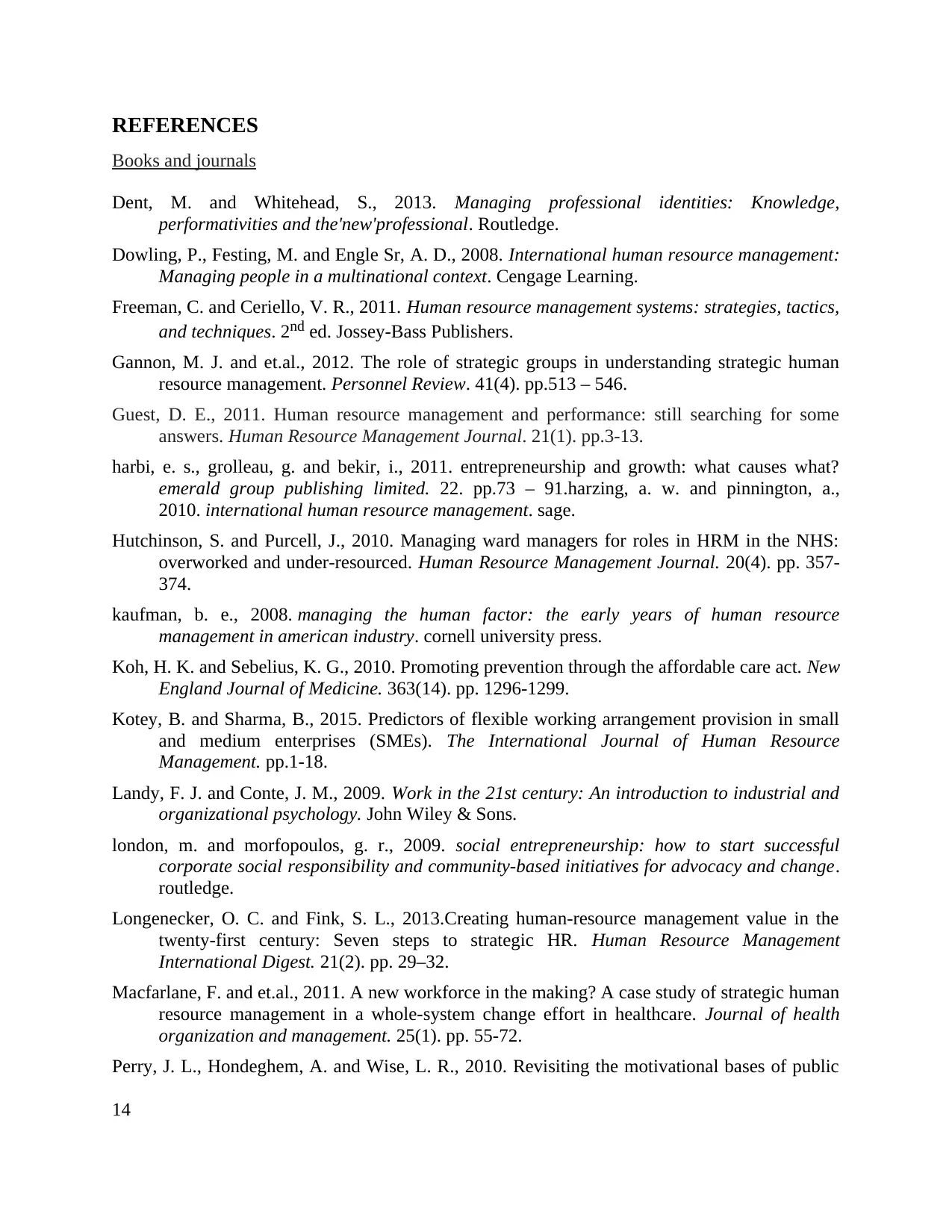
REFERENCES
Books and journals
Dent, M. and Whitehead, S., 2013. Managing professional identities: Knowledge,
performativities and the'new'professional. Routledge.
Dowling, P., Festing, M. and Engle Sr, A. D., 2008. International human resource management:
Managing people in a multinational context. Cengage Learning.
Freeman, C. and Ceriello, V. R., 2011. Human resource management systems: strategies, tactics,
and techniques. 2nd ed. Jossey-Bass Publishers.
Gannon, M. J. and et.al., 2012. The role of strategic groups in understanding strategic human
resource management. Personnel Review. 41(4). pp.513 – 546.
Guest, D. E., 2011. Human resource management and performance: still searching for some
answers. Human Resource Management Journal. 21(1). pp.3-13.
harbi, e. s., grolleau, g. and bekir, i., 2011. entrepreneurship and growth: what causes what?
emerald group publishing limited. 22. pp.73 – 91.harzing, a. w. and pinnington, a.,
2010. international human resource management. sage.
Hutchinson, S. and Purcell, J., 2010. Managing ward managers for roles in HRM in the NHS:
overworked and under‐resourced. Human Resource Management Journal. 20(4). pp. 357-
374.
kaufman, b. e., 2008. managing the human factor: the early years of human resource
management in american industry. cornell university press.
Koh, H. K. and Sebelius, K. G., 2010. Promoting prevention through the affordable care act. New
England Journal of Medicine. 363(14). pp. 1296-1299.
Kotey, B. and Sharma, B., 2015. Predictors of flexible working arrangement provision in small
and medium enterprises (SMEs). The International Journal of Human Resource
Management. pp.1-18.
Landy, F. J. and Conte, J. M., 2009. Work in the 21st century: An introduction to industrial and
organizational psychology. John Wiley & Sons.
london, m. and morfopoulos, g. r., 2009. social entrepreneurship: how to start successful
corporate social responsibility and community-based initiatives for advocacy and change.
routledge.
Longenecker, O. C. and Fink, S. L., 2013.Creating human-resource management value in the
twenty-first century: Seven steps to strategic HR. Human Resource Management
International Digest. 21(2). pp. 29–32.
Macfarlane, F. and et.al., 2011. A new workforce in the making? A case study of strategic human
resource management in a whole-system change effort in healthcare. Journal of health
organization and management. 25(1). pp. 55-72.
Perry, J. L., Hondeghem, A. and Wise, L. R., 2010. Revisiting the motivational bases of public
14
Books and journals
Dent, M. and Whitehead, S., 2013. Managing professional identities: Knowledge,
performativities and the'new'professional. Routledge.
Dowling, P., Festing, M. and Engle Sr, A. D., 2008. International human resource management:
Managing people in a multinational context. Cengage Learning.
Freeman, C. and Ceriello, V. R., 2011. Human resource management systems: strategies, tactics,
and techniques. 2nd ed. Jossey-Bass Publishers.
Gannon, M. J. and et.al., 2012. The role of strategic groups in understanding strategic human
resource management. Personnel Review. 41(4). pp.513 – 546.
Guest, D. E., 2011. Human resource management and performance: still searching for some
answers. Human Resource Management Journal. 21(1). pp.3-13.
harbi, e. s., grolleau, g. and bekir, i., 2011. entrepreneurship and growth: what causes what?
emerald group publishing limited. 22. pp.73 – 91.harzing, a. w. and pinnington, a.,
2010. international human resource management. sage.
Hutchinson, S. and Purcell, J., 2010. Managing ward managers for roles in HRM in the NHS:
overworked and under‐resourced. Human Resource Management Journal. 20(4). pp. 357-
374.
kaufman, b. e., 2008. managing the human factor: the early years of human resource
management in american industry. cornell university press.
Koh, H. K. and Sebelius, K. G., 2010. Promoting prevention through the affordable care act. New
England Journal of Medicine. 363(14). pp. 1296-1299.
Kotey, B. and Sharma, B., 2015. Predictors of flexible working arrangement provision in small
and medium enterprises (SMEs). The International Journal of Human Resource
Management. pp.1-18.
Landy, F. J. and Conte, J. M., 2009. Work in the 21st century: An introduction to industrial and
organizational psychology. John Wiley & Sons.
london, m. and morfopoulos, g. r., 2009. social entrepreneurship: how to start successful
corporate social responsibility and community-based initiatives for advocacy and change.
routledge.
Longenecker, O. C. and Fink, S. L., 2013.Creating human-resource management value in the
twenty-first century: Seven steps to strategic HR. Human Resource Management
International Digest. 21(2). pp. 29–32.
Macfarlane, F. and et.al., 2011. A new workforce in the making? A case study of strategic human
resource management in a whole-system change effort in healthcare. Journal of health
organization and management. 25(1). pp. 55-72.
Perry, J. L., Hondeghem, A. and Wise, L. R., 2010. Revisiting the motivational bases of public
14
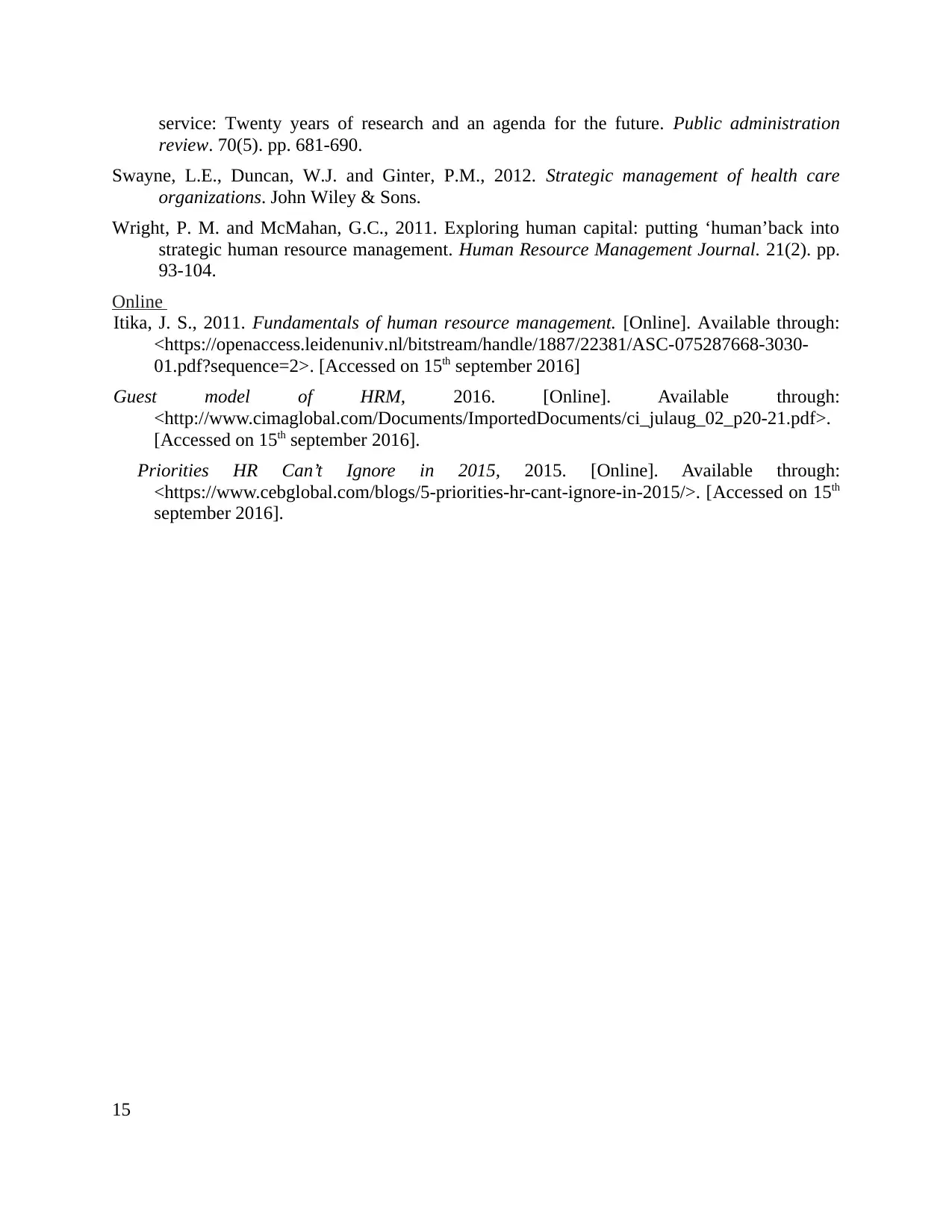
service: Twenty years of research and an agenda for the future. Public administration
review. 70(5). pp. 681-690.
Swayne, L.E., Duncan, W.J. and Ginter, P.M., 2012. Strategic management of health care
organizations. John Wiley & Sons.
Wright, P. M. and McMahan, G.C., 2011. Exploring human capital: putting ‘human’back into
strategic human resource management. Human Resource Management Journal. 21(2). pp.
93-104.
Online
Itika, J. S., 2011. Fundamentals of human resource management. [Online]. Available through:
<https://openaccess.leidenuniv.nl/bitstream/handle/1887/22381/ASC-075287668-3030-
01.pdf?sequence=2>. [Accessed on 15th september 2016]
Guest model of HRM, 2016. [Online]. Available through:
<http://www.cimaglobal.com/Documents/ImportedDocuments/ci_julaug_02_p20-21.pdf>.
[Accessed on 15th september 2016].
Priorities HR Can’t Ignore in 2015, 2015. [Online]. Available through:
<https://www.cebglobal.com/blogs/5-priorities-hr-cant-ignore-in-2015/>. [Accessed on 15th
september 2016].
15
review. 70(5). pp. 681-690.
Swayne, L.E., Duncan, W.J. and Ginter, P.M., 2012. Strategic management of health care
organizations. John Wiley & Sons.
Wright, P. M. and McMahan, G.C., 2011. Exploring human capital: putting ‘human’back into
strategic human resource management. Human Resource Management Journal. 21(2). pp.
93-104.
Online
Itika, J. S., 2011. Fundamentals of human resource management. [Online]. Available through:
<https://openaccess.leidenuniv.nl/bitstream/handle/1887/22381/ASC-075287668-3030-
01.pdf?sequence=2>. [Accessed on 15th september 2016]
Guest model of HRM, 2016. [Online]. Available through:
<http://www.cimaglobal.com/Documents/ImportedDocuments/ci_julaug_02_p20-21.pdf>.
[Accessed on 15th september 2016].
Priorities HR Can’t Ignore in 2015, 2015. [Online]. Available through:
<https://www.cebglobal.com/blogs/5-priorities-hr-cant-ignore-in-2015/>. [Accessed on 15th
september 2016].
15
1 out of 15
Related Documents
Your All-in-One AI-Powered Toolkit for Academic Success.
+13062052269
info@desklib.com
Available 24*7 on WhatsApp / Email
![[object Object]](/_next/static/media/star-bottom.7253800d.svg)
Unlock your academic potential
© 2024 | Zucol Services PVT LTD | All rights reserved.





